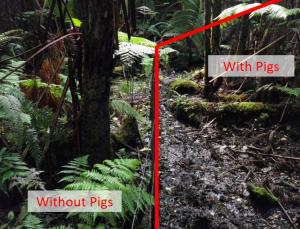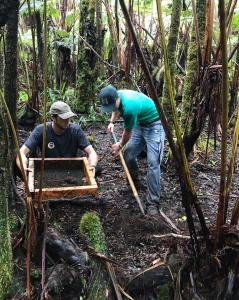UH Mānoa studies examine how feral pigs impact Hawai‘i’s forest ecosystems
University of Hawaiʻi at MānoaMS Student, Department of Natural Resources & Environmental Ma
Mark A Berthold, (808) 956-2405
Dir, Communication Srvcs, College of Tropical Agriculture and Human Resource
In Hawai‘i, feral pigs have cultural importance as well as serve as wild game for subsistence and recreational hunting. Researchers from the University of Hawai‘i at Mānoa College of Tropical Agriculture and Human Resources Departments of Natural Resources and Environmental Management and Tropical Plants and Soil Sciences collaborated on two related studies examining feral pigs and their significant impact on the island’s delicate ecosystems.
To answer the question, “How does feral pig removal affect soil bacterial and macroinvertebrate communities?,” researchers Nathaniel Wehr, Creighton Litton, Christian Giardina, Steven Hess, Noa Lincoln and Nhu Nguyen, used a 25-year chronosequence (ecological sites that share similar attributes, but represent different ages) of feral pig removal in Volcanoes National Park and Pu‘u Maka‘ala Natural Area Reserve.
Both studies highlight changes in soil communities associated with feral pig removal and help inform an increasingly common management scenario in Hawai‘i and beyond. The studies also attempt to balance the desire to eradicate feral pigs with the desire to maintain them for culture and recreation.
The first study, “Changes in soil bacterial community diversity following the removal of invasive feral pigs from a Hawaiian tropical montane wet forest,” published in Nature Scientific Reports reports that bacterial community diversity increased linearly over time following the removal of feral pigs, while functional diversity remained unchanged. This indicates feral pig removal increases soil bacterial redundancy, which likely promotes ecological resiliency of the soil.
In contrast, the second study, “Relationships between soil macroinvertebrates and nonnative feral pigs (Sus scrofa) in Hawaiian tropical montane wet forests” published in Biological Invasions, shows that soil macroinvertebrate communities did not change following feral pig removal. However, earthworms and ground beetles were positively associated with sites rooted by feral pigs.
The researchers’ worm-farming hypothesis suggests that changes to the soil from pig rooting, such as increased mixing of soil organic matter and reduced bulk density, improves earthworm habitat. Their alternative truffle-worm hypothesis suggests feral pigs are capable of intentionally seeking out soils with more below-ground food.
The removal of feral pigs is key to managing Hawai‘i’s forests, given the critical roles that soil microfauna (minute animals, especially those invisible to the naked eye) and mesofauna (very small invertebrates such as mites, nematodes or centipedes) have on forest ecosystems.
For more information, visit: https://www.nature.com/articles/s41598-019-48922-7.epdf?author_access_token


